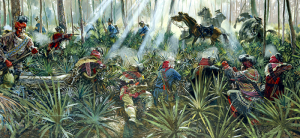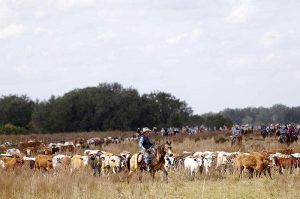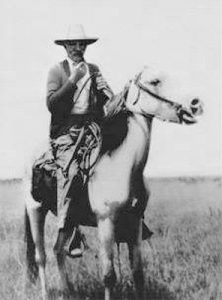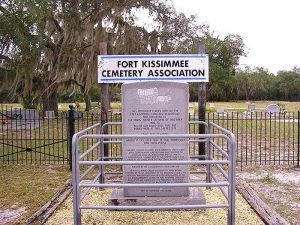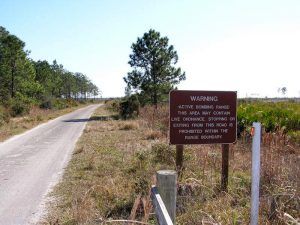Fort Kissimmee was both a military post and a settlement in Highlands County, Florida. Both are gone today.
In 1849, when another Indian war appeared to be brewing with the Seminole Indians, General David Twiggs opened the first trail across Florida that ran from Fort Brooke to Fort Capron. Along the trail, several forts were established, including Fort Arbuckle, Fort Kissimmee, and Fort Drum.
The actual structure known as Fort Kissimmee was built in January 1850. In its early years, it was only used intermittently because of repeated outbreaks of malaria among the soldiers garrisoned there. The fort was reactivated when the Third Seminole War erupted in late 1855.
A small civilian settlement grew around the military post, which was also called Fort Kissimmee. When the fort closed in 1858, only the central blockhouse and a few small outbuildings remained, but the civilian settlement around it continued to grow.
In 1859, when most of Southern Florida was still Seminole Indian territory, the U.S. government opened the northern half of Florida to free-range cattle grazing.
One of the founding residents of the town of Fort Kissimmee was Lewis Henry Thomas, who donated land for Fort Kissimmee’s first church, school, and cemetery. He also operated a barge ferry two miles upriver from the fort. Children from the surrounding ranchlands and some from the Polk County sawmill settlement of Kicco (pronounced Kisso) were ferried to school in Fort Kissimmee. Eventually, Kicco built its own school, but today, it too is a ghost town with nothing left but foundation stones and the sidewalk to the schoolhouse.
Isolated in the Florida Heartland, early transportation to and from the community was difficult because there were few established roads in the area. Most supplies were brought in by steamboats, which also hauled out the produce of the area farmers and cattle from the ranchers.
From 1885 to 1890, Thomas bought several large parcels of land along the Kissimmee River, where he ran cattle and hogs on the free range and also managed a citrus packinghouse in nearby Orange Hammock. In 1890, Lewis Thomas married Spicey Ann Underhill, and together, they raised nine children in their home on the riverbank. Thomas was affectionately called “Grandpa” by the entire community because he had a reputation for kindness and generosity.
In 1892, two hardscrabble cattlemen fought a duel to the death in Fort Kissimmee. When Henry Shaw allegedly stole a hog from another settler, he was seen by John Sheffield, who told the hog’s owner. As a result, Shaw challenged Sheffield to a duel, and the two men soon stood back-to-back with their guns ready. After they stepped off ten paces, both turned and fired, killing each other. Today, their remains lie side-by-side under a huge oak tree in Fort Kissimmee Cemetery.
During World War II, the U.S. Government “condemned” the land around Fort Kissimmee for an air force bombing range and the settlers were then mandatorily relocated. The Avon Park General Bombing and Gunnery Range officially opened in March 1942 on 107,059 acres of swamp and scrubland. The next year, the government acquired another 111,165 acres in Okeechobee County, which increased the size to approximately 352 square miles. The bombing range was originally a sub-base of MacDill Field in Tampa but became its own fully integrated airbase in November 1943.
Over the years, much of the land which comprised the Avon Park Air Force Range was declared surplus and disposed of. But today, it still encompasses 106,000 acres primarily used for military air-to-ground training operations. About 82,000 acres are open to the public for hunting, fishing, and recreation when military missions allow, typically on the weekends.
Today, all that is left of Fort Kissimmee is the cemetery, which is filled with the remains of other early settlers, including the Boney, McClelland, and Rimes families. It is one of the oldest Florida Heartland pioneer cemeteries.
Though it is located near the eastern boundary of the Avon Park Bombing Range, the cemetery was deeded to the Fort Kissimmee Cemetery Association in the 1950s and is still operated and maintained by descendants of those original families.
The cemetery is approximately 20 miles east of Avon Park, Florida. It is located on the Kissimmee River, at the east end of Kissimmee Road, within the boundaries of Avon Park Air Force Range.
The Air Force Range is closed to civilians at certain times, so visitors should call ahead for visiting hours. See more information Here.
© Kathy Alexander/Legends of America, updated November 2022.
Also See:
Sources:
Florida Counties
Ghost Towns
Museum of Florida History
Pioneer Families of the Kissimmee River Valley

